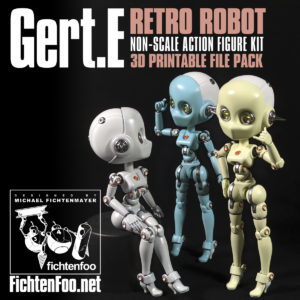Your cart is currently empty!
Painting the Zeon Cyclops Jeep
Every once in a while I decide to take a lot of step-by-step photos and make a tutorial out of them. I figured that this small jeep kit from the Gundam UC Hard Graph line would be a great piece to test out some techniques and write about the armor painting techniques I’ve picked up. So let’s get started!
1: First up of course is the pre-building of the kit. In the stage you cut, sand, and figure out how everything fits together, what will need masked, and what can be glued to start. Once done, parts can be attached to skewers and whatnot to hold them during the painting processes.
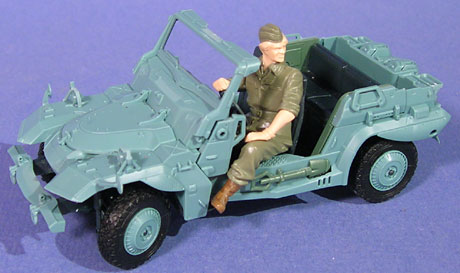
2: Primed jeep via airbrush with Mr Surfacer 1000 thinned with lacquer thinner and a few drops of Mr. Retarder Mild.
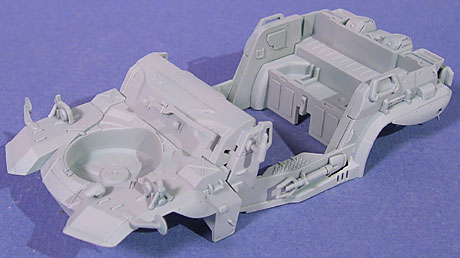
3: Sprayed jeep with gray then random swaths of Nato brown and a rust mixture. All Tamiya Acrylics. Later this will show through as random rust and primer coats under paint chips.

4: Clear-coated and sealed jeep with Future Floor Acrylic (FFA) thinned 50% with Tamiya Thinner.

5: 24 hours later 3 thin coats of hairspray (hair lacquer) were applied.

6: Jeep was sprayed with Olive green then parts were highlighted with JGSDF Olive Green which is a little lighter.

7: A few hours later, using clean water, various brushes were used to wet the model and loosen the water-soluable hairspray undercoat. This makes the topcoat of greens unstable temporarily so that they can realistically be chipped away with the wet brushes. Other implements (toothpicks, styrene card shards) can be used on the unstable surfaces to create line-scratches. Larger areas of paint can be removed as well as I did on the fenders. Remove as littler or as much as you want.

8: Now that the chipping is done, it’s time for decals. Normally I would coat the whole kit in gloss Future Floor Acrylic. This time however I just brushed a few thin coats where the decals would end up. Note the gloss on the front fenders.
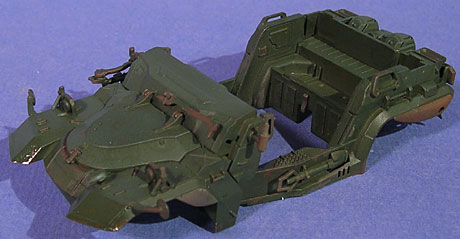
9: Decals were applied and tools, dashboard, seat cushions, and other hand-paint-necessary bits have been painted. Mirrors and lights were painted with silver. Later clear Tamiya was applied where necessary based on the light color.
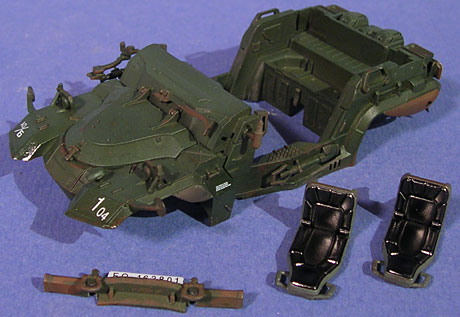
10: Now a satin coat of FFA was applied. This seals the topcoat from firther chipping attempts, accidental or not and seals the surface for the solvent-based weathering apps.

11: Next up, three applications of filters have been applied to all the jeep parts. Filters are kind of like a wash, but not really… they’re hard to explain, but add a lot to the depth of a model. For this filter I mixed up a pale blue-green oil-paint mix with some turpenoid. This alters the color slightly and blends colors together between the various colored parts. It also “seasons” or tooths the surface slightly for the next step, discoloration. Note also as I go, more and more of the jeep gets put together. This is based on what needed painted when and with minimal masking.
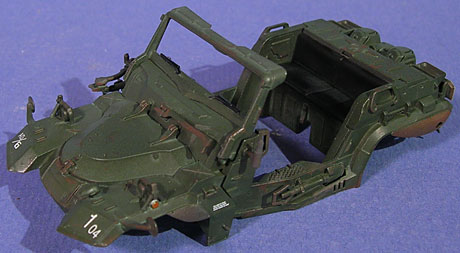

12: Once the filters have dried/cured for 24 hours, it’s time for the discoloration. This technique involves applying small dabs of various oil colors then blending them in with a thinner dampened brush. This gives the surface more variation in color and a more realistic and deep appearance.
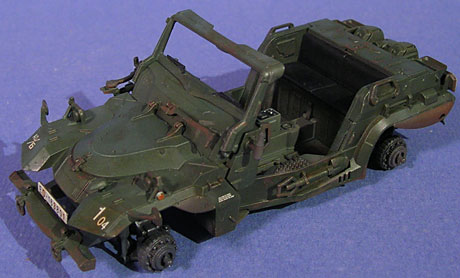
13: After the discoloration has dried, about 24 hours, a wash is applied. This wash is a mix of oil paint to a dirt-color then thinned with turpenoid. This thin wash is applied to the whole vehicle and all external parts such as wheels, seats, etc… While it’s drying you might notice pools or water (thinner)-lines. These can be blended out with a stuff soft brush before the wash fully cures. Another 24 hours.
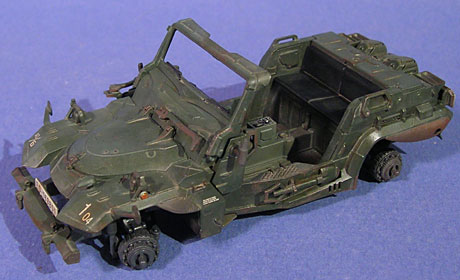
14: Next up is pre-dusting with the airbrush. For this I’ve mixed Tamiya Flat Earth with Flattened FFA to make a semi-transparent dirt-mix. This is sprayed in very light mistings where larger amounts of dust would collect. Side skirts, underside, and the rear pannel. More specific dusting effects will be added next with pgment powders.
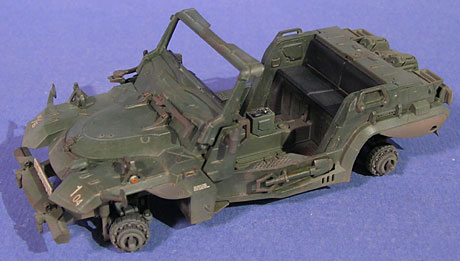
15: The windshield was masked off where the window wipers would hit. Then the windshield was lightly sprayed with my Tamiya Flat Earth + Flat FFA mix.
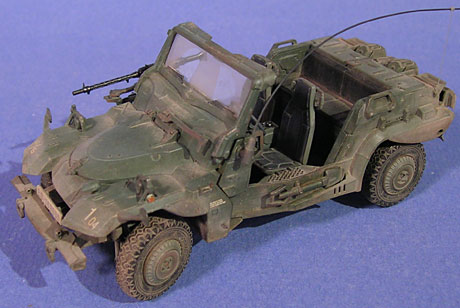
16: The tires were painted in flat black then had a satin finish applied. Pigments were dusted onto the wheels and then rubbed off with rubber gloves. This removes all the pigment except for what’s around raised edges and in the treads. A little bit of pigments were then brushed around the road-hitting edge of the tire since it’s been running on a dirt road and would pick that dirt up.

17: The machine gun was painted in flat black and given a flattened FFA coat. Powdered graphite was rubbed over the weapon to give it its gunmetal sheen. After it was attached to the jeep it had just a little disty pigment applied since the weapon would generally be removed and kept very clean and maintained.
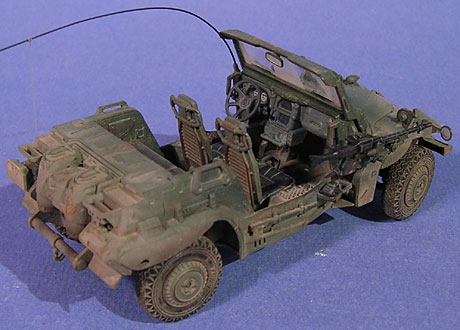
18: Pigment powders were applied dry with various brushes. Thinner was applied to these dry pigments to affix them to the surface better. The end result is still fragile and should not be handled much, especially not with bare hands as that could leave fingerprints in the finish. The underside and rear panel recieved a lot of pigment, while the rest just got dust added in specific places. A little powdered graphite was rubbed onto the floor grates and sides where the crews feet would rub/polish the surface.
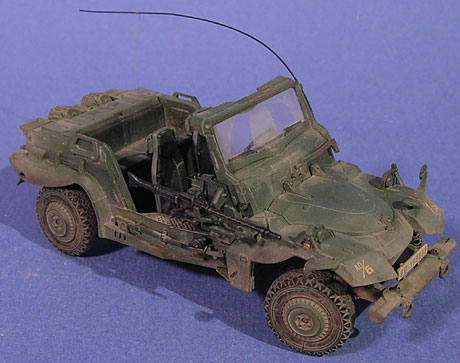
19: And that’s pretty much it. Different colors and conditions would call for different pigments but these techniques can work for just about any armor/robot subject. I hope they can help you and as for me, this tutorial will help me remember what I did for next time!






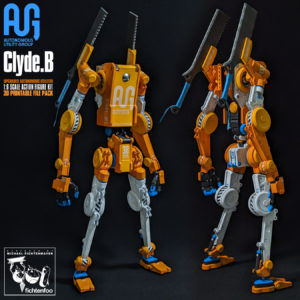
![Maude [Cyborg Action-Doll] (Files Only)](https://fichtenfoo.net/blog/wp-content/uploads/2023/01/Maude-Promos-300x300.jpg)
